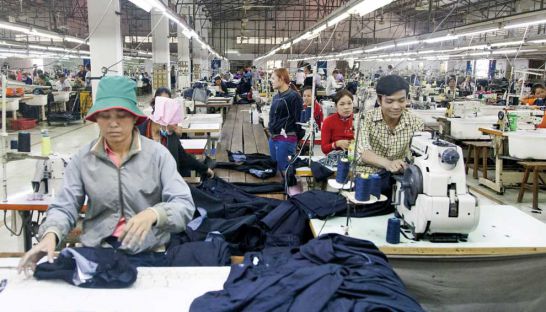Cambodia: Garment exports to slow
Cambodia’s garment and footwear exports will likely see a slower percentage of growth this year at around 5 percent, compared with 7 percent in 2016, a trend that industry insiders dismissed as not being indicative of an overall decline or linked to the current political situation.
Speaking yesterday at the annual Cambodia Textile Summit, Ken Loo, secretary-general of the Garment Manufacturers Association in Cambodia, said that slower growth in the garment and footwear sector was a normal market occurrence as the overall production base increases.
“As your base number gets bigger and bigger, in terms of percentage growth, you cannot expect to grow at the same rate forever,” he said. “So far, the trade [in the garment industry] has not been affected by the current situation yet.”
Despite Loo being unable to release export figures for the first nine months of this year, he did add that 25 new factories had opened in Cambodia this year while 53 had shuttered operations.
While he was generally positive about the industry’s health, he warned that the increase of the minimum wage – going from $153 a month to $170 a month effective January 1 – would cause the Kingdom to gradually lose its competitive advantage as a low-cost destination. He urged the government to help reduce the cost of doing business, warning that manufacturers will soon need to increase productivity to remain competitive in the footloose industry.
“Going forward, with the minimum wage going to $170, more factories will encounter difficulties if the other things don’t change,” he said. “So, we hope that there is a change in productivity, a lowering of cost of doing business, and there will be new government policy that helps us offset the rising labour cost and allows factories to continue to operate.”
According to data from the Customs Department, Cambodia exported $7.3 billion worth of apparel and footwear products in 2016, compared to $6.8 billion in 2015. The sector accounts for more than 70 percent of the country’s total exports with the vast majority of its products destined for the EU, US and Canada.
Eric Tavernier, CEO of We Group Ltd, a French firm that operates a garment factory in Sihanoukville, explained that the price difference associated with the minimum wage hike was marginally symbolic in a regional sense as productivity remained a paramount concern.
“On the paper monthly salary is 60 percent cheaper in Cambodia compared to China,” he said. “But the production speed in Cambodia is only 35 percent compared to 75 percent in China, which at the end of the day only makes Cambodia 30 percent cheaper when efficiency is factored in.”
Meanwhile, the latest economic outlook released last week by the International Monetary Fund predicted that the Kingdom’s garment sector would grow at a slower pace owing to increased competition from neighbouring countries. However, the IMF said that preferential US trade access for specific travel-related items could help prop up the sector in the near-term.
Enjoy Ho, president of the textile enterprise association at the Chinese Chamber of Commerce in Cambodia, said that the Kingdom’s advantages for attracting investment into the garment sector remains its abundance of cheap labour and preferential trade status under the EU’s Everything But Arms scheme and duty-free access to the US for travel goods.
However, he opined that the minimum wage hike would surely jeopardise the sector if worker productivity does not increase.
“With the increasing of the minimum wage, we are struggling to keep the same order price compared to previous years,” he said. “We have very small survival space.”
He said that if the government did not act quickly to decrease the burden on factory owners, whether that is by cutting electricity costs or lowering import and export fees, “factories will definitely close”.
Source: http://www.phnompenhpost.com/business/garment-exports-slow


 English
English




